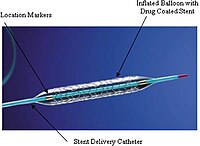
Photo from wikipedia
Introduction In recent years, the new third-generation ultrathin bioresorbable-polymer sirolimus-eluting stent (BP-SES), characterized by some of the thinnest struts among commercially available devices (60–80 μm) and an amorphous silicon carbide… Click to show full abstract
Introduction In recent years, the new third-generation ultrathin bioresorbable-polymer sirolimus-eluting stent (BP-SES), characterized by some of the thinnest struts among commercially available devices (60–80 μm) and an amorphous silicon carbide coating, has been introduced for the treatment of coronary artery disease (CAD). The present study aimed to assess different clinical outcomes and safety of this drug-eluting stent in male and female patients in a real-world setting. Methods The present study is a retrospective analysis including all patients treated with BP-SES between January 2017 and December 2019 at a single high-volume center. Follow-up data, including stress test results and clinical setting, were collected during outpatient visits or by telephone contact. Patients symptomatic for angina or with a positive stress test were addressed to CT scan/coronary angiogram. The main study outcome was target lesion failure (TLF), defined as a composite of cardiovascular death, target vessel myocardial infarction, or target lesion revascularization. Results Overall, 66 (15.9%) female and 349 (84.1%) male patients were included; women were older (median age 70 vs. 66, P = 0.003) and with a lower body mass index (BMI) (25.0 vs. 26.1, P = 0.010) compared to men, with no other relevant differences in baseline characteristics. Indication for percutaneous coronary intervention (PCI) was acute coronary syndrome in 86 (20.7%) of the cases, with no significant differences between male and female patients. A total of 558 lesions were treated with BP-SES stents, 90 in women and 468 in men (1.36 vs. 1.34 lesions per patient, P = 0.83); cumulative stent length (33.6 vs. 38.4 mm, P = 0.078), and mean stent diameter (2.92 vs. 3.0 mm, P = 0.39) did not differ in women compared to men. Technical and clinical successes were achieved in all patients. Stent thrombosis (ST) occurred in 2 (0.5%) patients, both men. TLF occurred in 10 (2.9%) men and 2 (3.0%) women after a median follow-up of 402 days, without significant differences at log-rank analysis (2.34 events per 100 patient-years in men, 2.53 in women; P = 0.80). Conclusion Ultrathin struts BP-SES showed to be a safe and effective option for the treatment of CAD in both women and men, with a very low ST rate and favorable long-term outcomes.
Journal Title: Frontiers in Cardiovascular Medicine
Year Published: 2021
Link to full text (if available)
Share on Social Media: Sign Up to like & get
recommendations!